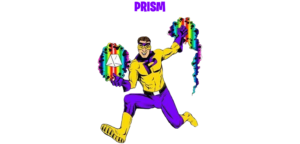Strengthen Your Cognitive and Perceptual Flexibility by Leveraging the Powers of Prism

…has the unique ability to stretch and flex his cognitive and perceiving thinking muscles to expand wide beyond current boundaries or to contract in between the lines. This gives him the flexibility to cobble together new, and unique idea combinations. Being a student of physics, he has keen insight and realizes that ideas have varying frequencies and can flow and refract in different directions. He displays a resilient ability to maintain versatility and flexibility. And working with his Sidekick Micro-Burst, together they develop an abundance of novel and truly unique ideas, solutions and concepts.
His Powers are:
- Borrow It
- Elaborate
- Make New Combinations
Take these actions this week to strengthen your cognitive and perceiving flexibility, to anchor the creative habit to be repeatable and to Get Creativity Fit!
- Our minds learn and are programmed to repeat success patterns and are not programed to proactively look for new patterns. It’s at the core of evolution and biological reproduction. As a result, we can think about and perceive that existing ideas and concepts are good because we are familiar with them. So the trap we set for ourselves is that many innovative ideas and concepts are generally wrong because they break from our success patterns – what we are familiar and comfortable with – the way we know how to do it and the way we know it will work. To break this pattern, practice the skill/technique of Borrow It – to think analogically and borrow ideas from one context and apply them in another. Integrate excursions into your weekly routine and go on a wide variety of physical field visits that include interviews, observing and walking the processes where you want to gain a deeper insight. Look for ideas in unique places and ask: ‘How to apply/force-connect these ideas to my current challenge, problem or opportunity?’
- Consciously breaking from the past and our current way of doing things is contrary to being efficient and getting our work done. It is more efficient and productive to repeat the success patterns and methods that we know. It takes conscious effort and time to break current success pattern connections and then to develop new success pattern connections. To break this pattern, practice the skill/technique of Elaborate, but not Excessively by adding enough detail to ideas/alternatives/concepts to improve, embellish or transform them. Ask: ‘How to exaggerate it?’ ‘How to increase the value?’ ‘How to make it stronger?’ ‘How about adding in a secret sauce ingredient or two?’ When you present the idea, communicate the essence of it by showing its relationship to something that is known, understood and valued by your audience.
- Organizing for creative work is the inverse of everyday work. With everyday work we want to eliminate variance and repeat tasks the same way every time. We want zero variance and a zero failure rate. Conversely, organizing for creative work is juxtaposed – variance is the lifeblood of creativity. You need to foster and accelerate variance by forcing yourself to be exposed to lots of diverse stimulus…light the match…break from habit… perceive things differently…make many new connections. A high rate of experimentation is necessary. Thomas Edison conducted over 5,000 experiments before he was successful in making the filament of an incandescent light bulb that lasted long enough and was cheap enough to be commercially viable. To break this pattern practice the skill/technique of Make New Combinations by taking something that currently exists and adapt it to develop new applications, purposes, relationships or uses. Integrate more incubation time periods into your problem solving, idea finding efforts. Use the natural power of incubation to pause, step away from the issue, put some distance between you and it and don’t prematurely force a decision. Let your ideas flow freely and allow your innate associative thinking capabilities to do their work.